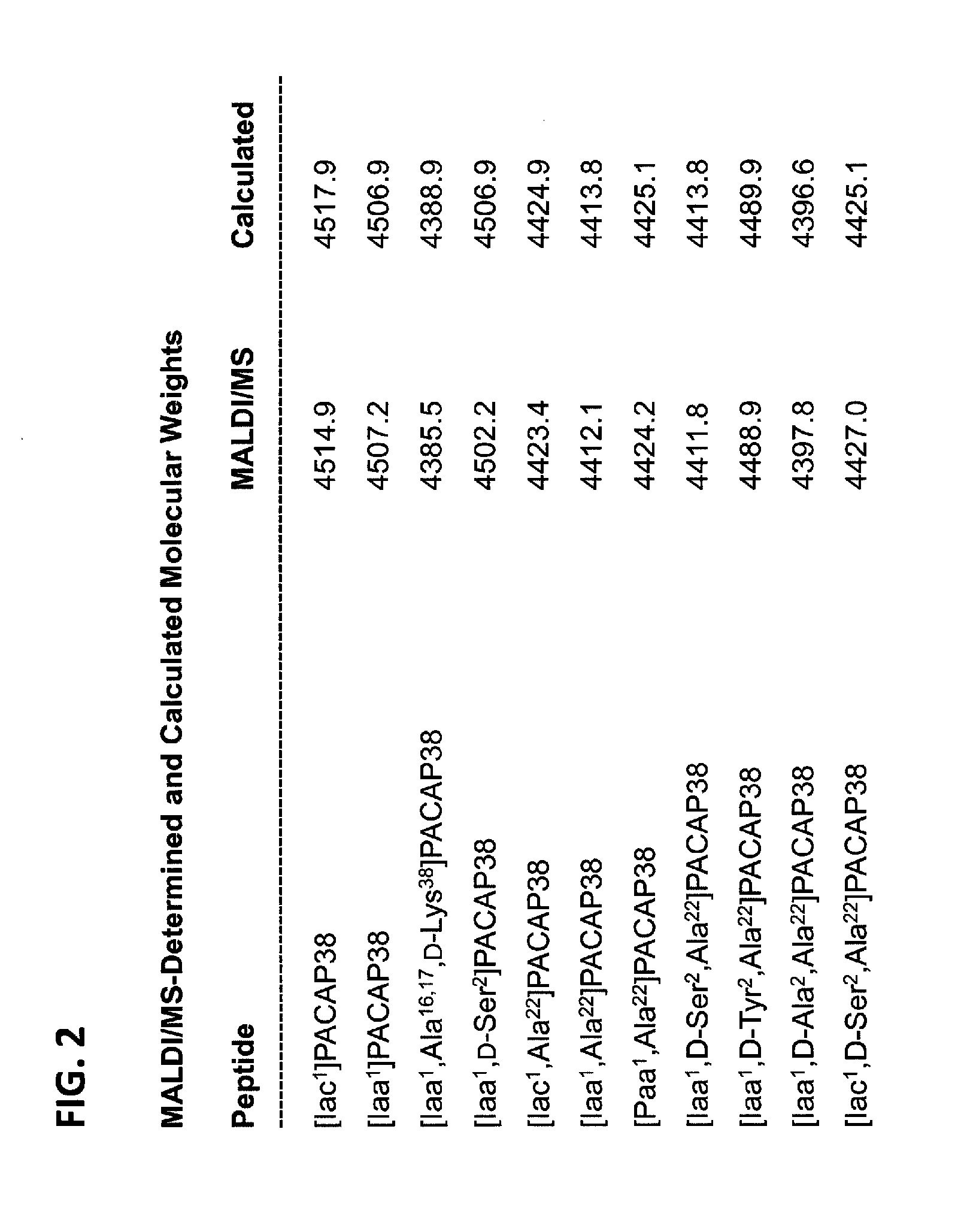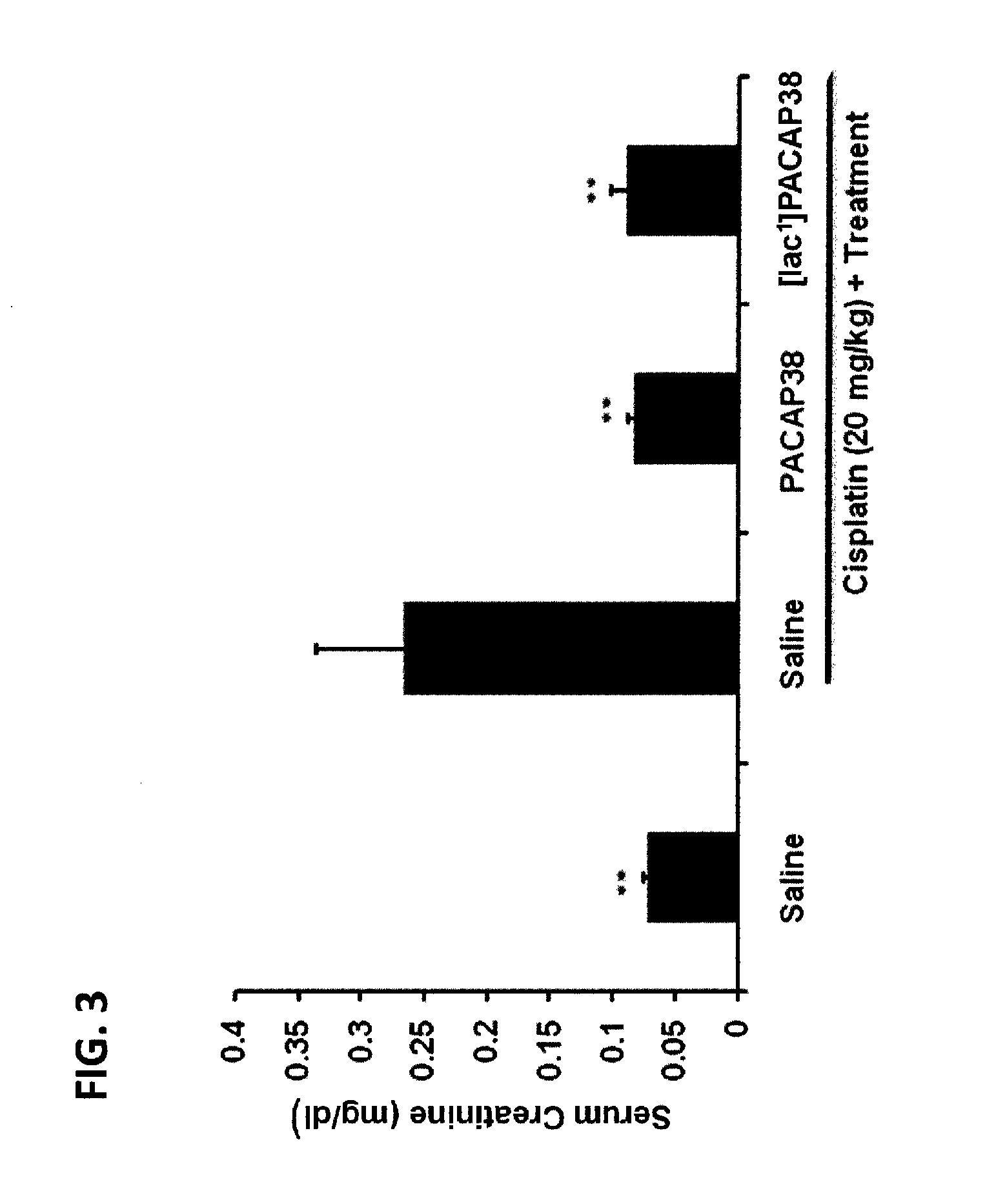Analogs of pituitary adenylate cyclase-activating polypeptide (PACAP) and methods for their use
a technology of cyclase activation and peptide, which is applied in the field of analogues of pituitary adenylate cyclase activating polypeptide (pacap), can solve the problems of short half-life in the circulation of peptides for neuroprotection in the brain, poor transport across the blood-brain barrier, and the effect of reducing one or more injuries
- Summary
- Abstract
- Description
- Claims
- Application Information
AI Technical Summary
Benefits of technology
Problems solved by technology
Method used
Image
Examples
example 1
PACAP Analogs
[0291]Peptides can have extraordinarily high affinities for their cognate receptors. The major drawback of using native peptides as therapeutics is their short half-life in the circulation after parenteral administration due mainly to rapid proteolysis and rapid filtration by the kidney. Therefore, analogs of PACAP have been made in order to reduce the rates of proteolysis and / or renal clearance. In addition, other changes have been made in the native amino-acid sequences of PACAP27 and PACAP38 in order to reduce the cost of synthesis, and alter tissue distribution and / or receptor specificity.
[0292]Eleven peptide analogs of PACAP38 have been made by solid-phase synthesis (SEQ ID NOs 4-14; FIG. 2) using the procedures briefly described above.
[0293]The in vivo biological properties of one of these seven PACAP analogs are illustrated below (FIGS. 3-8) and the potential medical applications for these PACAP analogs suggested by these illustrations are briefly outlined.
example 2
Reduction of Cisplatin-Induced Cytotoxicity by PACAP38 and [Iac1]PACAP38
[0294]Cisplatin (cis-diamminedichloridoplatinum(II), Platinol) is the first-in-class platinum-based DNA-crosslinking anticancer therapeutic. It was approved for clinical use by the U.S. FDA in 1978. The other members of this class of “alkylating-like” platinum-based anticancer agents now include (but are not limited to) carboplatin, oxaliplatin and satraplatin. Cisplatin is one of the most widely used cancer chemotherapeutics and is the cornerstone of many multi-drug anticancer regimens. Nephrotoxicity is usually the “dose-limiting” toxicity for the use of cisplatin in cancer chemotherapy, but sensory neuropathies can sometimes limit the doses that can be used to treat some patients.
[0295]The cytoprotective effect of PACAP38 and [Iac1]PACAP38 against cisplatin-induced nephrotoxicity was determined in a common in vivo model (Li et al., J Mol Neurosci 43:58-66, 2011). The mice treated with only cisplatin had impai...
example 3
Changes in Arterial Blood Pressure by PACAP38 Analogs
[0297]PACAP38 is a directly-acting arterial vasodilator and an indirectly-acting arterial vasoconstrictor. The rapid vasodilator response to intravenous administration of PACAP38 is due to stimulation of PAC1, VPAC1 and VPAC2 receptors in the blood vessels, while the slightly delayed vasoconstrictor response is mainly due to stimulation of PAC1 receptors in the adrenal medulla and the subsequent release of adrenal catecholamines. Therefore, PACAP38 analogs with different patterns of binding to the three PACAP / VIP receptors would produce different patterns of arterial blood pressure responses following systemic administration. The critical parameter for picking a PACAP38 analog for treating a specific disease is not potency but therapeutic index.
[0298]Substitution of the amino acid histidine in position 1 of PACAP38 by either imidazole acetic acid or imidazole acrylic acid resulting in PACAP38 analogs with significant biological ac...
PUM
| Property | Measurement | Unit |
|---|---|---|
| Fraction | aaaaa | aaaaa |
| Fraction | aaaaa | aaaaa |
| Fraction | aaaaa | aaaaa |
Abstract
Description
Claims
Application Information
 Login to View More
Login to View More - R&D
- Intellectual Property
- Life Sciences
- Materials
- Tech Scout
- Unparalleled Data Quality
- Higher Quality Content
- 60% Fewer Hallucinations
Browse by: Latest US Patents, China's latest patents, Technical Efficacy Thesaurus, Application Domain, Technology Topic, Popular Technical Reports.
© 2025 PatSnap. All rights reserved.Legal|Privacy policy|Modern Slavery Act Transparency Statement|Sitemap|About US| Contact US: help@patsnap.com



